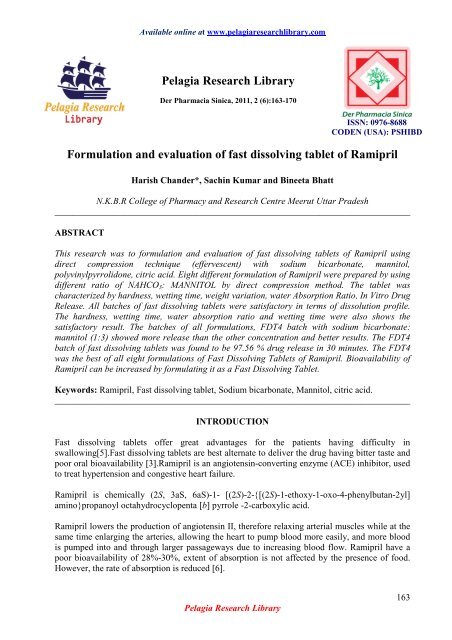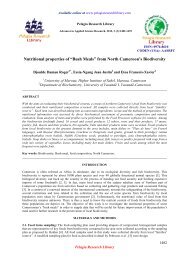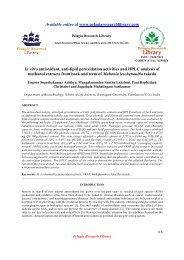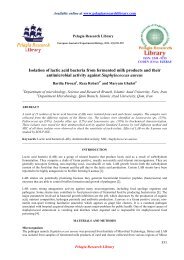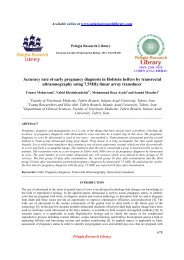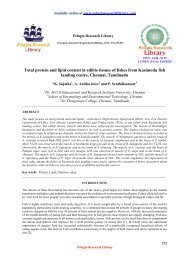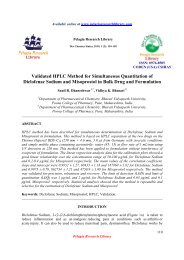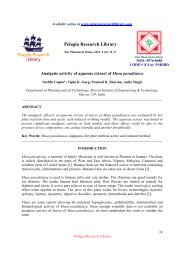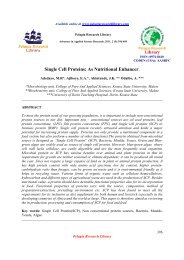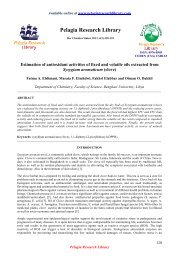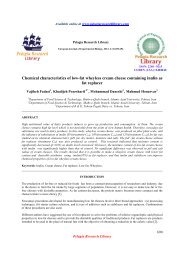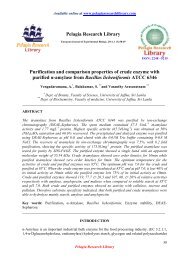Formulation and evaluation of fast dissolving tablet of - Pelagia ...
Formulation and evaluation of fast dissolving tablet of - Pelagia ...
Formulation and evaluation of fast dissolving tablet of - Pelagia ...
Create successful ePaper yourself
Turn your PDF publications into a flip-book with our unique Google optimized e-Paper software.
Available online at www.pelagiaresearchlibrary.com<br />
<strong>Pelagia</strong> Research Library<br />
Der Pharmacia Sinica, 2011, 2 (6):163-170<br />
ISSN: 0976-8688<br />
CODEN (USA): PSHIBD<br />
<strong>Formulation</strong> <strong>and</strong> <strong>evaluation</strong> <strong>of</strong> <strong>fast</strong> <strong>dissolving</strong> <strong>tablet</strong> <strong>of</strong> Ramipril<br />
Harish Ch<strong>and</strong>er*, Sachin Kumar <strong>and</strong> Bineeta Bhatt<br />
N.K.B.R College <strong>of</strong> Pharmacy <strong>and</strong> Research Centre Meerut Uttar Pradesh<br />
______________________________________________________________________________<br />
ABSTRACT<br />
This research was to formulation <strong>and</strong> <strong>evaluation</strong> <strong>of</strong> <strong>fast</strong> <strong>dissolving</strong> <strong>tablet</strong>s <strong>of</strong> Ramipril using<br />
direct compression technique (effervescent) with sodium bicarbonate, mannitol,<br />
polyvinylpyrrolidone, citric acid. Eight different formulation <strong>of</strong> Ramipril were prepared by using<br />
different ratio <strong>of</strong> NAHCO3: MANNITOL by direct compression method. The <strong>tablet</strong> was<br />
characterized by hardness, wetting time, weight variation, water Absorption Ratio, In Vitro Drug<br />
Release. All batches <strong>of</strong> <strong>fast</strong> <strong>dissolving</strong> <strong>tablet</strong>s were satisfactory in terms <strong>of</strong> dissolution pr<strong>of</strong>ile.<br />
The hardness, wetting time, water absorption ratio <strong>and</strong> wetting time were also shows the<br />
satisfactory result. The batches <strong>of</strong> all formulations, FDT4 batch with sodium bicarbonate:<br />
mannitol (1:3) showed more release than the other concentration <strong>and</strong> better results. The FDT4<br />
batch <strong>of</strong> <strong>fast</strong> <strong>dissolving</strong> <strong>tablet</strong>s was found to be 97.56 % drug release in 30 minutes. The FDT4<br />
was the best <strong>of</strong> all eight formulations <strong>of</strong> Fast Dissolving Tablets <strong>of</strong> Ramipril. Bioavailability <strong>of</strong><br />
Ramipril can be increased by formulating it as a Fast Dissolving Tablet.<br />
Keywords: Ramipril, Fast <strong>dissolving</strong> <strong>tablet</strong>, Sodium bicarbonate, Mannitol, citric acid.<br />
______________________________________________________________________________<br />
INTRODUCTION<br />
Fast <strong>dissolving</strong> <strong>tablet</strong>s <strong>of</strong>fer great advantages for the patients having difficulty in<br />
swallowing[5].Fast <strong>dissolving</strong> <strong>tablet</strong>s are best alternate to deliver the drug having bitter taste <strong>and</strong><br />
poor oral bioavailability [3].Ramipril is an angiotensin-converting enzyme (ACE) inhibitor, used<br />
to treat hypertension <strong>and</strong> congestive heart failure.<br />
Ramipril is chemically (2S, 3aS, 6aS)-1- [(2S)-2-{[(2S)-1-ethoxy-1-oxo-4-phenylbutan-2yl]<br />
amino}propanoyl octahydrocyclopenta [b] pyrrole -2-carboxylic acid.<br />
Ramipril lowers the production <strong>of</strong> angiotensin II, therefore relaxing arterial muscles while at the<br />
same time enlarging the arteries, allowing the heart to pump blood more easily, <strong>and</strong> more blood<br />
is pumped into <strong>and</strong> through larger passageways due to increasing blood flow. Ramipril have a<br />
poor bioavailability <strong>of</strong> 28%-30%, extent <strong>of</strong> absorption is not affected by the presence <strong>of</strong> food.<br />
However, the rate <strong>of</strong> absorption is reduced [6].<br />
<strong>Pelagia</strong> Research Library<br />
163
Harish Ch<strong>and</strong>er et al Der Pharmacia Sinica, 2011, 2(6):163-170<br />
______________________________________________________________________________<br />
Ramipril is a prodrug <strong>and</strong> is converted to the active metabolite ramiprilat by liver esterase<br />
enzymes. Ramiprilat is mostly excreted by the kidneys. The half-life <strong>of</strong> ramiprilat is variable (8–<br />
18 hours) [12], <strong>and</strong> is prolonged by heart <strong>and</strong> liver failure, as well as kidney failure. It is mainly<br />
used for the Hypertension, Congestive heart failure, following myocardial infarction in patients<br />
with clinical evidence <strong>of</strong> heart failure. Susceptible patients over 55 years: prevention <strong>of</strong><br />
myocardial infarction, stroke, cardiovascular death or need <strong>of</strong> revascularization procedures,<br />
Diabetic nephropathy with microalbuminuria.<br />
The rate <strong>and</strong> extent <strong>of</strong> dissolution <strong>of</strong> the drug from any solid dosage form, determines the rate<br />
<strong>and</strong> extent <strong>of</strong> absorption <strong>of</strong> the drug. In the case <strong>of</strong> poorly water- soluble drugs, dissolution is the<br />
rate-limiting step in the process <strong>of</strong> drug absorption. Potential bioavailability problems are<br />
prevalent with highly lipophillic drugs (log p octanol/water, 3.32) due to erratic or incomplete<br />
absorption from GIT [6].<br />
Fast <strong>dissolving</strong> Tablet formulation has been widely <strong>and</strong> successfully applied to improve the<br />
dissolution, solubility, <strong>and</strong> consequently the bioavailability <strong>of</strong> poorly water-soluble drugs.<br />
Because <strong>of</strong> its poor aqueous solubility, Ramipril may pose dissolution related absorption<br />
problem. In the present study, an attempt had been made to prepare <strong>fast</strong> <strong>dissolving</strong> <strong>tablet</strong>s <strong>of</strong><br />
Ramipril in the oral cavity with enhanced dissolution rate & hence improved patient compliance<br />
using sodium bicarbonate <strong>and</strong> mannitol.<br />
MATERIALS AND METHODS<br />
Ramipril was received as gift sample from Torrent Pharmaceuticals Limited, Gujarat, India.<br />
Sodium bi carbonate, polyvinyl pyrrolidine, citric acid, magnesium Stearate were supplied by<br />
Central Drug House (P) Ltd., New Delhi, India <strong>and</strong> mannitol was supplied by Qualigens Fine<br />
Chemicals, Mumbai.<br />
2.1 Calibration Curve <strong>of</strong> Ramipril in 6.8 Ph Phosphate Buffer:<br />
2.1.1 Preparation <strong>of</strong> 6.8 pH phosphate buffer [13]:<br />
Prepare a 0.2 M solution <strong>of</strong> potassium dihydrogen phosphate by <strong>dissolving</strong> 27.218 gm <strong>of</strong><br />
substance in 1000 ml <strong>of</strong> distilled Water.<br />
Prepare a 0.2 M solution <strong>of</strong> sodium hydroxide solution by <strong>dissolving</strong> 8 gm <strong>of</strong> substance in<br />
1000 ml <strong>of</strong> distilled Water.<br />
Take 50 ml <strong>of</strong> above prepared potassium dihydrogen phosphate solution & 22.4 ml <strong>of</strong> above<br />
prepared sodium hydroxide solution. Add both the solution & make the volume <strong>of</strong> the resultant<br />
solution 200 ml. Calibrate the solution for using pH meter & adjust the pH 6.8.<br />
2.1.2 Preparation <strong>of</strong> stock solution:<br />
Dissolve 10 mg <strong>of</strong> Ramipril in few ml <strong>of</strong> phosphate buffer by taking 100 ml volumetric flask &<br />
make up the volume 100 ml to get a solution <strong>of</strong> 100 mcg/ml concentration solutions.<br />
2.1.3 Procedure:<br />
Prepare different concentrations from 10 mcg/ml to 60 mcg/ml by diluting stock solution as for<br />
first concentration 10 mcg/ml, take 1 ml <strong>of</strong> stock solution & dilute with 10 ml <strong>of</strong> buffer solution<br />
.Similarly other concentrations are prepared .Absorbance are measured at 231nm for each<br />
concentration by using UV spectrophotometer (UV-3000, Lab India).Concentration are plotted<br />
against absorbance on a graph paper.<br />
<strong>Pelagia</strong> Research Library<br />
164
Harish Ch<strong>and</strong>er et al<br />
Der Pharmacia Sinica, 2011, 2(6): 2(6):163-170<br />
______________________________________________________________________________<br />
Table no. 1 -Calibration curve in 6.8 pH phosphate buffer<br />
S.No. Concentration (µg/mL) Absorbance<br />
1 10 0.308<br />
2 20 0.646<br />
3 30 0.987<br />
4 40 1.304<br />
5 50 1.612<br />
6 60 1.954<br />
Figure No. 11-(Concentration<br />
Vs Absorbance)<br />
Calibration curve for: Ramipril<br />
Solvent / Mobile Phase: Buffer (pH 6.8)<br />
Wavelength (nm): 231 nm<br />
2.2 <strong>Formulation</strong> Development [2, 4]: 4]:-<br />
Different batches <strong>of</strong> <strong>tablet</strong>s prepared by wet granulation method. Eight different batches <strong>of</strong><br />
<strong>tablet</strong>s were prepared by taking sod. bicarbonate, polymer ratio 1:0, 1:1, 1:2, 1:3 1:4 1:5 5:1 4:2<br />
<strong>of</strong> each with PVP. Thus total eight batches were prepared (Different combination shown in table<br />
2).<br />
2.2.1 Sieving: : Mg. Stereate was sieved through #60 mesh.<br />
2.2.2 Granulation: All the ingredients were mixed in increasing order <strong>of</strong> weights. The binding<br />
solution <strong>of</strong> PVP in Isopropyl propyl alcohol was used as granulating solvent. The granules were made<br />
using #40 mesh. Then granules were dried in oven at 40 0 All the ingredients were mixed in increasing order <strong>of</strong> weights. The binding<br />
propyl alcohol was used as granulating solvent. The granules were made<br />
C for 15 minutes.<br />
2.2.3 Compression: The <strong>tablet</strong>s were compressed on a single punch <strong>tablet</strong>ing machine<br />
(Bells India Marketed <strong>and</strong> Manufactured by Meditron Ing. New Delhi) for 250mg <strong>tablet</strong><br />
respectively.<br />
<strong>Pelagia</strong> Research Library<br />
165
Harish Ch<strong>and</strong>er et al Der Pharmacia Sinica, 2011, 2(6):163-170<br />
______________________________________________________________________________<br />
Table no. 2- Composition <strong>of</strong> FDTs <strong>of</strong> Ramipril (250 mg <strong>tablet</strong>s)<br />
Batches(mg/<strong>tablet</strong>s) FDT FDT FDT FDT FDT FDT FDT FDT<br />
Ingredients 1 2 3 4 5 6 7 8<br />
NaHCO3:Mannitol 1:0 1:1 1:2 1:3 1:4 1:5 5:1 4:1<br />
Ramipril 20 20 20 20 20 20 20 20<br />
NaHCO3 220 100 66.6 50 40 33.3 166.6 160<br />
Mannitol 0 100 133.3 150 160 166.6 33.3 40<br />
Citric Acid 6 6 6 6 6 6 6 6<br />
PVP 20 20 20 20 20 20 20 20<br />
Talc 2 2 2 2 2 2 2 2<br />
Mg. Stearate 2 2 2 2 2 2 2 2<br />
3. Evaluation <strong>of</strong> Tablets:-<br />
The <strong>tablet</strong>s were evaluated for appearance, hardness, friability, In-vitro drug release <strong>and</strong> floating<br />
lag time <strong>and</strong> total floating time.<br />
3.1 Bulk density [9]:<br />
Apparent bulk density (g/ml) was determined by placing pre-sieved bulk powder blend into a<br />
graduated cylinder via a large cylinder <strong>and</strong> measuring the volume <strong>and</strong> weight “as it is.<br />
Where, p b =Bulk Density”<br />
M = Weight <strong>of</strong> sample in gm<br />
V = Final volume <strong>of</strong> blend in cm 3<br />
3.2 Tapped density [9]:<br />
It was determined by placing known mass <strong>of</strong> powder in a graduated cylinder & tapping it for<br />
fixed number <strong>of</strong> taps (around 250) until the powder bed volume reached a minimum. Using the<br />
weight <strong>of</strong> the powder in the cylinder <strong>and</strong> this volume, the tapped density was computed. (Table<br />
No. 3).<br />
3.3 Angle <strong>of</strong> repose [9]:<br />
The angle <strong>of</strong> repose was calculated with the formula tan a =H/R, where ‘a’ is the angle <strong>of</strong> repose<br />
<strong>and</strong> R is the radius <strong>of</strong> the conical pile.<br />
Therefore θ = Tan -1 h/r<br />
Pb= M / V p<br />
Where θ = Angle <strong>of</strong> repose<br />
h = height <strong>of</strong> the cone<br />
r= Radius <strong>of</strong> the cone base<br />
Tan θ = h/r<br />
Angle <strong>of</strong> Repose less than 30 ° shows the free flowing <strong>of</strong> the material<br />
3.4 Compressibility Index [9]:<br />
The compressibility index <strong>of</strong> the granules was determined by Carr’s compressibility index.<br />
<strong>Pelagia</strong> Research Library<br />
166
Harish Ch<strong>and</strong>er et al Der Pharmacia Sinica, 2011, 2(6):163-170<br />
______________________________________________________________________________<br />
Where, TBD= Tapped bulk density<br />
LBD= Lowest bulk density<br />
%Carr Index= (TBD-LBD) ×100/TBD<br />
3.5 Hardness [6, 8]:<br />
Hardness <strong>of</strong> <strong>tablet</strong> is defined as the force applied across the diameter <strong>of</strong> the <strong>tablet</strong> in order to<br />
break the <strong>tablet</strong>. The resistance <strong>of</strong> the <strong>tablet</strong> to chipping, abrasion or breakage under condition <strong>of</strong><br />
storage transformation <strong>and</strong> h<strong>and</strong>ling before usage depends on its hardness. Hardness <strong>of</strong> <strong>tablet</strong>s<br />
was measured using a Monsanto hardness Tester.<br />
3.6 Friability [8, 9]:<br />
It is a measure <strong>of</strong> mechanical strength <strong>of</strong> <strong>tablet</strong>s. Roche Friabilator was used to determine the<br />
friability by following procedure: Preweighed <strong>tablet</strong>s were placed in the Roche friabilator<br />
(Electro lab EFL Friabilator, Mumbai, India) <strong>and</strong> expressed in the percentage by using this<br />
formula.<br />
Friability(%) = Initial weight – Final weight × 100<br />
Initial weight<br />
3.7 Weight variation study [6, 8, <strong>and</strong> 10]:<br />
With a <strong>tablet</strong> designed to contain a specific amount <strong>of</strong> drug in a specific amount <strong>of</strong> formula, the<br />
weight <strong>of</strong> a <strong>tablet</strong> being made is routinely measured to ensure that a <strong>tablet</strong> contains proper<br />
amount <strong>of</strong> drug. 20 Tablets were taken from each batch. The <strong>tablet</strong>s were weighed <strong>and</strong> the mean<br />
was calculated. The following formula was applied for checking deviation from normal range as<br />
per U.S.P. st<strong>and</strong>ards.<br />
3.8 Water absorption ratio <strong>and</strong> wetting time [8]:<br />
A piece <strong>of</strong> tissue paper folded twice was placed in a Petridish containing 5ml <strong>of</strong> water. A pre<br />
weighed <strong>tablet</strong> was placed on the paper <strong>and</strong> the time for complete wetting was measured which is<br />
characterized by coloring <strong>of</strong> <strong>tablet</strong>. The wetted <strong>tablet</strong> was then weighed. Water absorption ration<br />
R was determined according to the following formula.<br />
R = (Wa- Wb/ Wb) 100<br />
Where, Wa = weight <strong>of</strong> <strong>tablet</strong> after absorption <strong>of</strong> water<br />
Wb= weight <strong>of</strong> <strong>tablet</strong> before absorption <strong>of</strong> water<br />
3.9 In vitro Dissolution studies [7, 8, <strong>and</strong> 13]:<br />
In vitro dissolution studies <strong>of</strong> <strong>fast</strong>-<strong>dissolving</strong> <strong>tablet</strong>s were performed by using(type 2 USP<br />
dissolution) apparatus as specified in at 50 rpm; <strong>and</strong> Sorenson’s buffer (pH,6.8), 900 ml, was<br />
used as dissolution medium , temperature <strong>of</strong> dissolution medium was maintained at 37 0 C±0.5 0 C.<br />
Sample <strong>of</strong> dissolution medium was withdrawn at a specific time interval <strong>and</strong> was filtered.<br />
Absorption <strong>of</strong> filtered solution was checked by UV spectroscopy (Lab India Uv 3000), <strong>and</strong> drug<br />
<strong>Pelagia</strong> Research Library<br />
167
Harish Ch<strong>and</strong>er et al Der Pharmacia Sinica, 2011, 2(6):163-170<br />
______________________________________________________________________________<br />
content was determined from st<strong>and</strong>ard calibration curve. Dissolution rate was studied for all<br />
designed formulation.<br />
RESULTS AND DISCUSSION<br />
Eight formulations <strong>of</strong> Fast Dissolving Tablets <strong>of</strong> Ramipril were prepared with varying<br />
concentration <strong>of</strong> Sodium bicarbonate: Mannitol <strong>and</strong> also Citric acid, PVP were used as diluents<br />
(Table. no. 2). For each formulation, blend <strong>of</strong> drug <strong>and</strong> excipients were prepared <strong>and</strong> evaluated<br />
for various parameters as explained earlier. The powder blend was compressed using direct<br />
compression technique.<br />
Table no. 3- Evaluation data <strong>of</strong> Micromeritic property <strong>of</strong> bulk powder blend<br />
Different Batches FDT<br />
Micromeritic properties 1<br />
FDT<br />
2<br />
FDT<br />
3<br />
FDT<br />
4<br />
<strong>Pelagia</strong> Research Library<br />
FDT<br />
5<br />
FDT<br />
6<br />
FDT<br />
7<br />
FDT<br />
8<br />
Bulk Density (gm/cm3) 0.96 0.69 0.56 0.50 0.43 0.41 0.82 0.83<br />
Tapped Density (gm/cm3) 1.09 0.79 0.63 0.57 0.50 0.48 0.92 0.95<br />
Angle <strong>of</strong> Repose ( 0 ) 25.34 24.42 26.34 24.24 25.66 25.47 24.98 26.64<br />
Compressibility Index (%) 11.92 12.65 10.93 13.26 12.72 13.30 10.66 12.14<br />
Bulk density, was found in the range <strong>of</strong> (0.41-0.96 gm/cm3) <strong>and</strong> the tapped density between<br />
(0.48-1.09 g/cm3).The compressibility index was found between (10.66-13.30) which indicates a<br />
fairly good flowbility <strong>of</strong> the powder blend. The good flowability <strong>of</strong> the powder blend was also<br />
evidenced with angle <strong>of</strong> repose in the range <strong>of</strong> (24.24-26.64) which is below 40( 0 ) indicating<br />
good flow properties <strong>of</strong> the granules (Table no.3)<br />
Table no. 4- Evaluation data <strong>of</strong> compressed <strong>tablet</strong>s <strong>of</strong> different formulations<br />
Different Batches FDT FDT FDT FDT FDT FDT FDT FDT<br />
Evaluation data 1 2 3 4 5 6 7 8<br />
Hardness (kg/cm2) 2.3 2.8 3.2 3.8 4.1 4.2 2.5 2.7<br />
Friability (%) 0.51 0.43 0.41 0.42 0.43 0.42 0.43 0.47<br />
Weight variation(mg) 251.2 252.6 250.4 250.0 254.1 253.6 249.5 250.3<br />
Water absorption ratio 102.2 130.5 145.8 156.8 153.9 155.0 150 149.5<br />
Wetting Time (sec) 174 165 159 152 145 143 160 155<br />
Batches<br />
Table no. 5:- % Drug release <strong>of</strong> Different Batches<br />
% DRUG RELEASE<br />
TIME<br />
(min)<br />
FDT1 FDT2 FDT3 FDT4 FDT5 FDT6 FDT7 FDT8<br />
0 0 0 0 0 0 0 0 0<br />
5 52.21 53.67 55.41 60.41 57.87 55.78 58.21 60.15<br />
10 65.34 78.89 85.67 90.23 80.89 78.56 75.34 69.34<br />
15 69.98 80.65 88.56 92.31 87.56 82.34 79.7 74.5<br />
20 75.67 85.67 91.23 96.42 90.87 84.5 83.6 78.6<br />
30 78.34 88.56 95.58 99.91 97.56 95.67 93.67 86.8<br />
Tablets were prepared using direct compression technique. Since the powder material was free<br />
flowing, <strong>tablet</strong>s were obtained <strong>of</strong> uniform weight due <strong>of</strong> uniform die fill, with acceptable weight<br />
variations as per I.P. The average weight <strong>of</strong> the prepared <strong>tablet</strong> was found 249 to 254 mg. All the<br />
<strong>tablet</strong>s were exhibit in white colour, odourless, smooth surface with zero defects. A <strong>tablet</strong><br />
requires certain amount <strong>of</strong> hardness to withst<strong>and</strong> the mechanical shocks in h<strong>and</strong>ling, packaging<br />
168
Harish Ch<strong>and</strong>er et al<br />
Der Pharmacia Sinica, 2011, 2(6): 2(6):163-170<br />
______________________________________________________________________________<br />
<strong>and</strong> at the time <strong>of</strong> application. The friability <strong>of</strong> all the formulation was found to be less than 1.0<br />
%. The hardness <strong>of</strong> the prepared <strong>tablet</strong> varied from 2.3 to 4.2 Kg/cm2 which have satisfactory<br />
strength to withst<strong>and</strong> the mechanical shocks (Table no.4).<br />
Figure no. 22-<br />
% Drug release <strong>of</strong> Different Batches<br />
The % drug release <strong>of</strong> different batches with time shown in (Table no.5) <strong>and</strong> Figure no. 2 shown<br />
that the formulations F4 with 99.91 % (mannitol +sodium bicarbonate) show more release than<br />
the <strong>tablet</strong>s with only sodium bicarbonate. All the formulations showed no significant variation in<br />
all the parameters rs under the test period.<br />
CONCLUSION<br />
The Fast Dissolving Tablets have potential advantages over conventional dosage forms, with<br />
their improved patient compliance; convenience bioavailability <strong>and</strong> rapid onset <strong>of</strong> action had<br />
drawn the attention <strong>of</strong> many manufacturers over a decade. The preparation process <strong>of</strong> direct<br />
compression <strong>tablet</strong>s includes co co-grinding grinding <strong>of</strong> all the excipients before compression, resulting the<br />
increase in the solubility due to the reduction in the effective particle size <strong>of</strong> the drug following<br />
increase in the wetting <strong>of</strong> drug particl particle e by the excipients <strong>and</strong> improved dissolution <strong>of</strong> drugs. drugs.Fast<br />
Dissolving Tablet formulation obtained by some <strong>of</strong> these technologies has sufficient mechanical<br />
strength quick disintegration / dissolution in the mouth without water water.<br />
In conclusion , overall resul results ts suggests that the FDTs containing sodium bicarbonate <strong>and</strong><br />
mannitol in the ratio <strong>of</strong> 1:3 (F4) shows best results in terms <strong>of</strong> percent drug release,<br />
compressibility index, hardness <strong>and</strong> disintegration time. Thus FDTs may be developed for<br />
Ramipril, for quick onset nset <strong>of</strong> action without need <strong>of</strong> water for swallowing or administration,<br />
however further studies are investigations are needed to confirm the in vivo efficiency <strong>and</strong> for<br />
the development <strong>of</strong> Fast Dissolving Tablet <strong>of</strong> Ramipril.<br />
Acknowledgements<br />
Authors are thankful to Principal, Pr<strong>of</strong>essor R. Hemalatha, NKBR College <strong>of</strong> pharmacy <strong>and</strong><br />
research centre for providing me all facilities <strong>and</strong> encouragement for successful completion <strong>of</strong><br />
this work.<br />
<strong>Pelagia</strong> Research Library<br />
169
Harish Ch<strong>and</strong>er et al Der Pharmacia Sinica, 2011, 2(6):163-170<br />
______________________________________________________________________________<br />
REFERENCES<br />
[1.] Setia Anupama, Goyal Naveen <strong>and</strong> Kansal Sahil, <strong>Pelagia</strong> Research Library, Der Pharmacia<br />
Sinica, 2011, 2(1):36-39.<br />
[2.] Nayankumar C.Ratanakar <strong>and</strong> Bhupendra G.Prajapati, <strong>Pelagia</strong> Research Library, Der<br />
Pharmacia Sinica, 2011, 2(2):333-340.<br />
[3.] Ch<strong>and</strong>rasekaran Arcot Ravindran, <strong>Pelagia</strong> Research Library, Der Pharmacia Sinica, 2011,<br />
2(4):218-240.<br />
[4.] Mahaveer Pr.Khinchi, M.K.Gupta, Anil Bh<strong>and</strong>ari, Natasha Sharma <strong>and</strong> Dilip<br />
Agrawal,Scholars Research Library, Der Pharmasinica Lettre,2011,3(2)-108-118.<br />
[5.] Kamal Saroha, Pooja Mathur, Surender Verma, Navneet Syon <strong>and</strong> Ajay Kumar, <strong>Pelagia</strong><br />
Research Library., Der Pharmacia Sinica,2010, 1(1) :179-187.<br />
[6.] Shafiq-un-Nabi S, Shakeel F, Talegaonkar S, Ali J, Baboota S, Ahuja A, Khar RK, Ali<br />
M., AAPS PharmSciTech. 2007, 8(2): Article 28.<br />
[7.] Kumaresan C., Orally Disintegrating Tablet-Rapid Disintegration, Sweet Taste, <strong>and</strong> Target<br />
Release Pr<strong>of</strong>ile, 2008.<br />
[8.] Biradar S.S., Bhagvati S.T., Kuppasdad I.J., The Internet Journal <strong>of</strong> Pharmacology, 2006<br />
Volume 4 Number 2.<br />
[9.] Sharma Shailesh, New Generation <strong>of</strong> Tablet: Fast Dissolving Tablet, 2008<br />
[10.] Lachman.L, Lieberman.A, Kinig.J.L. The Theory <strong>and</strong> Practice <strong>of</strong> Industrial Pharmacy, 4th<br />
edition, Varghese Publishing House, Bombay.1991: 67-68<br />
[11.] Reddy, L.H., B. <strong>and</strong> Rajneesh, Indian J. Pharm. Sci., 2002, 64(4): 331-336<br />
[12.] KD Tripathi, Essentials <strong>of</strong> Medical Pharmacology. 6th Ed. New Delhi: Medical Publishers<br />
(p) Ltd.; 1999. P.no. 485.<br />
[13.] Pharmacopoeia <strong>of</strong> India. New Delhi: Ministry <strong>of</strong> Health <strong>and</strong> Family Welfare, Government<br />
<strong>of</strong> India, Controller <strong>of</strong> Publications; 2007.<br />
<strong>Pelagia</strong> Research Library<br />
170


